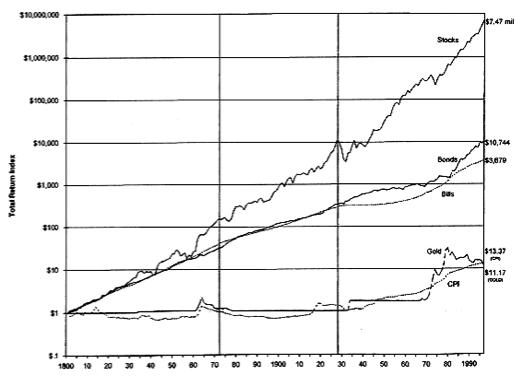Last night’s election results came a shock to many people. If the past is any predictor of the future, I would expect a lot of our clients to feel incredibly unsettled as a result. The situation reminds me a lot of what happened immediately after the Brexit vote. Most people have forgotten that the FTSE 100 (an index of the 100 largest market cap stocks on the London Stock Exchange) declined 3.15% the first day after the vote, but finished the week up 1.99%. Markets around the world dropped, recovered, dropped again and then rose to a level well in excess of where they were before the election.
So what’s our advice for worried investors? Same as always:
Do nothing.
What History Teaches Us
If there’s anything the day-by-day machinations of the market teach us, it’s that slow and steady wins the race. Investors have long known that staying the course is one of the most important things to do – it’s just emotionally hard to execute. Some of the best research on this topic comes from the so-called “Wizard of Wharton” – University of Pennsylvania professor Jeremy Siegel. In his New York Times bestselling book, Stocks for the Long Run, Siegel looked at the performance of equities from 1802 through 1997, the year the book was first published.
His findings were astonishing: Despite the day-to-day volatility that we all feel, the actual long-run returns of stocks are remarkably consistent.
Here’s how he summarized his findings:
“Despite extraordinary changes in the economic, social, and political environment over the past two centuries, stocks have yielded between 6.6 and 7.2 percent per year after inflation in all major subperiods. The wiggles on the stock return line represent the bull and bear markets that equities have suffered throughout history. The long-term perspective radically changes one’s view of the risk of stocks. The short-term fluctuations in market, which loom so large to investors, have little to do with the long-term accumulation of wealth.
His last line bears repeating: The short-term fluctuations in market, which loom so large to investors, have little to do with the long-term accumulation of wealth.
Siegel found that almost no matter what period you looked at, stocks delivered about 7% after inflation. The Civil War, World War I, World War II, even the Great Depression (marked by the second black vertical line) were hiccups compared to the overall trend.
The pattern repeats in other countries, including those that have experienced catastrophic collapses. World War II, for example, sheared 90% off the value of German equities … but German stocks completely rebounded by 1958, rising 30% per year on average from 1948 to 1960. They went on from there to new highs. Averaged out over the long haul, their return is a consistent 6.6% real return … a figure that continues through this day.
The same is true for Japan, the UK, and all other markets that Siegel has studied; in the short-run, volatility, but in the long run, profits.
Don’t Buy What They’re Selling
The reason we don’t hear much about the power of long-term investing – and the truth about the futility of trading – is that long-term investing is boring and cheap. The financial media thrives by encouraging you to panic, and large parts of the financial industry make money only when you act. Big moves sell newspapers, and high trading activity means commissions for online brokers. The only people who don’t profit from that activity are investors themselves, because as it turns out, we can’t predict the future.
It’s hard to stare down a significant market correction and stick to your plan. When the US government shut down in September 2013 during the budget showdown, we saw a large number of our clients refrain from continuing to add deposits. The same was true during the Greek Crisis. They paid handsomely for missing out on the rebound. If you invest regularly, harvest your losses and rebalance your portfolio, you’ll end up benefiting from market corrections in multiple ways. It won’t be easy. But over the long haul, it will really pay off.
Disclosure
Nothing in this article should be construed as a solicitation or offer, or recommendation, to buy or sell any security. The information provided here is for educational purposes only and is not intended as investment advice. The analysis uses information from third-party sources, which Wealthfront believes to be accurate; however Wealthfront does not guarantee the accuracy of the information. There is a potential for loss as well as gain in investing. Wealthfront does not provide personalized financial planning to investors, such as estate, tax, or retirement planning. Investment advisory services are only provided to investors who become Wealthfront Clients (“Clients”) pursuant to a written Client Agreement, which investors are urged to read and carefully consider in determining whether such agreement is suitable for their individual facts and circumstances.
About the author(s)
Andy Rachleff is Wealthfront's co-founder and Executive Chairman. He serves as a member of the board of trustees and chairman of the endowment investment committee for University of Pennsylvania and as a member of the faculty at Stanford Graduate School of Business, where he teaches courses on technology entrepreneurship. Prior to Wealthfront, Andy co-founded and was general partner of Benchmark Capital, where he was responsible for investing in a number of successful companies including Equinix, Juniper Networks, and Opsware. He also spent ten years as a general partner with Merrill, Pickard, Anderson & Eyre (MPAE). Andy earned his BS from University of Pennsylvania and his MBA from Stanford Graduate School of Business. View all posts by Andy Rachleff




